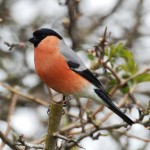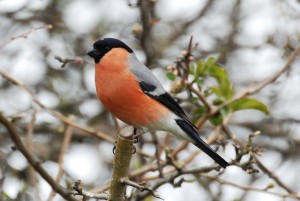
 Images courtesy of RSPB.org
Images courtesy of RSPB.org
Our little country cottage has suffered a cruel double whammy during the last month. The shock of a blustery and wet autumn replacing the warmest and longest summer in recent memory has been exacerbated by the disappearance of our beloved bullfinches from the garden. It may be the abundance of soft fruit and seeds, or perhaps they are away catching bugs and spiders; whatever the reason, we have been mourning their loss keenly and wondering what happened to our colourful feathered friends.
For five months the bullfinches were ever present on the bird table that sits in front of our kitchen window. At any time during the day, assuming the jackdaws, wood pigeons and collared doves had had their fill, one or both would take their place on the table alongside chattering sparrows, a cocky robin, assorted tits, chaffinches and the occasional jenny wren. What struck us both was the never ending conversation between the male and female: barely audible, supportive and comforting (well, that is how they sounded to us) peep peeps issued from the table to the hawthorn hedge or gangly buddleia, where one or other of the pair (usually the male) kept faithful watch while the other pecked at seeds and nuts, especially their beloved nigella. One of the greatest gifts this summer bestowed on us was to hear the gently whistled chats through the window on first waking up. Listening to bullfinches is like catching a covert and whispered conversation between innocents. The knowledge that these beautiful birds are elusive, private and at best infrequent garden visitors made every sighting special and washing up in front of the window has never been so enjoyable.

So when we hadn’t seen the male for a few days we began to worry. The typical life expectancy of a bullfinch is around two years and even though we told ourselves it had moved on, we both feared something more fatal had occurred. The female continued to appear at the table; in fact, if anything it was around more than ever. Watching it eat nervously at the bird table while looking around and peeping away was bittersweet to say the least. It’s so difficult not to ascribe human characteristics to animals and birds (especially those we are familiar with) and we worried that it was lonely, afraid and vulnerable. Then something quite wonderful happened.

Around dusk one evening, out of the corner of my eye, I spotted the female in one of its favourite shrubs which was in full fruit. Close by I also saw the silhouette of – surely not? – another bullfinch! Two days later I disturbed the female on the bird table and as it took flight along the familiar route over the hedge and up the lane into a line of elder and apple trees, I was sure I saw two, even three, bullfinches following. The black and white tails were evidence enough for me and I ran up the steps into the house to break the good news to my other half. We had a family!
Over the next few days we were able to confirm that the female was feeding three shy juveniles, or rather, it was teaching them to feed themselves. They were out of the nest, keeping close to Mum, but they had to learn to eat seeds and fruit rather than whatever had been brought to them in their very early days. This quiet family stayed with us for a week or so and then last week they were suddenly gone and now we’ve given up speculating, having agreed that they are away up the lane, eating as many berries and nuts as their small but swollen bellies will take.
The loss of the bullfinches has been tempered by the arrival, most evenings just before dusk turns into full darkness, of a pair of tawny owls. We’ll save their story for another day.






